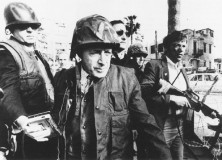The Reagan Administration’s Response to the Crisis in Lebanon — Aref N. Hassan

INTRODUCTION:
After absorbing many years of cross border attacks from Lebanon by the Palestinian Liberation Organization (PLO), Israel invaded its neighbor in 1982. Recognizing the repercussions the evolving situation in Lebanon could have on the Middle East and the Cold War balance of power, the United States felt compelled to respond. President Ronald Reagan immediately sent Philip Habib, his special Middle East envoy, to broker a cease-fire and later ordered U.S. troops to Lebanon as part of a Multi National Force (MNF). However, the MNF operation quickly fell apart when terrorists attacked the U.S. embassy and Marine barracks in Beirut. The attacks brought about the departure of U.S. forces from Lebanon, leaving the country in chaos and U.S. interests significantly damaged.
STRATEGY:
At the time of the 1982 Lebanon crisis, the administration viewed the Middle East in terms of containment of Moscow. Despite the urging of regional analysts and leaders, the White House gave little attention to resolving the Arab-Israeli conflict. The events of 1982 in Lebanon, for the most part, took Washington by surprise. The U.S. government responded with an ad hoc policy which highlighted the fact that the Reagan administration did not have a clear set of policies or objectives when it came to the Levant. The United States initially responded by taking part in the MNF which was deployed to oversee the evacuation of PLO guerillas from Beirut. Later, the United States took on a much larger role that included attempting to broker a peace deal between Lebanon and Israel, securing the withdrawal of Syrian and Israeli forces from Lebanon, and rebuilding and strengthening the Lebanese central government in an attempt to stabilize the country and end its civil war.
INTEGRATED ELEMENTS OF NATIONAL POWER:
There was no consensus on the position the United States should take towards Israel in response to the invasion or on whether or not U.S. troops should be sent into Lebanon as part of the MNF. Disagreements among departments, secretaries, and presidential advisors on the proper course of action were due to different cost-benefit calculations. While the Department of State (DOS) looked forward to the potential political benefits of success in Lebanon, the Department of Defense (DOD) did not want to put troops in harm’s way. Secretary of Defense Caspar Weinberger’s view was that Lebanon was of no strategic importance to the United States and thus not worth the price of involvement. The Pentagon was also concerned about deploying troops without a clear mission or objective. The National Security Council (NSC) as a whole, favored the DOS perspective and convinced President Reagan to go ahead and send in peacekeepers.
EVALUATION:
Institutional tensions between DOS and the White House and between the State and Defense departments, in particular between the secretary of state and the secretary of defense, contributed to disagreement over political-military strategy in Lebanon. The administration’s interagency process did not resolve these conflicts. As a result, the military deployment to Lebanon was not part of a coherent strategy. The United States had set what may be considered adequate political goals: withdrawal of all foreign forces, strengthening the government of Lebanon, and momentum for larger Middle East peace negotiations. What was not clear, however, was how the military was going to be used as an effective instrument of foreign policy to achieve those stated goals. There was also a disconnect between high- and mid-level officials within the foreign policy establishment, unclear authority in the Reagan foreign policy decision making structure, and a lack of foreign policy experience and knowledge of the Middle East among decision makers.
RESULTS:
The only tangible achievement of the U.S. response was supervising the successful evacuation of PLO guerillas from Beirut. In contrast, the costs of the failure for the United States were high. In the short-term, the loss of 258 American lives and the financial burden of the military deployment were the most significant costs. In the long-term, the United States lost prestige in the Middle East and, more dangerously, the premature withdrawal from Lebanon gave terrorists like Osama bin-Laden the impression that the United States government would “cut and run” whenever it encountered American casualties.
CONCLUSION:
Given the continued conflict in Lebanon and across the Middle East, it is important to understand why the United States acted as it did and what the short-term and long-term effects of these actions were on America’s prestige and influence. The U.S. government response to the crisis in Lebanon was dictated by systemic/structural flaws in the Reagan administration which produced an incoherent, ad hoc response to the crisis. Notably, there was a disconnect between high- and mid-level officials within the national security system, ambiguous lines of authority in foreign policy decision making, and a lack of regional experience on the part of decision makers.